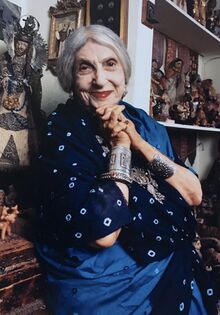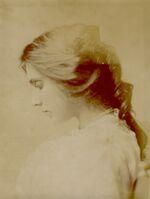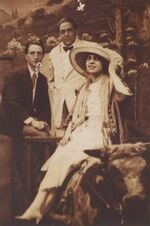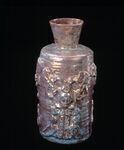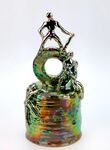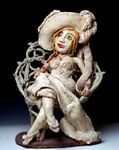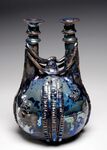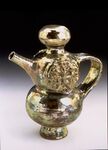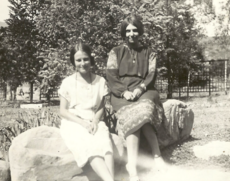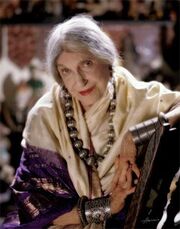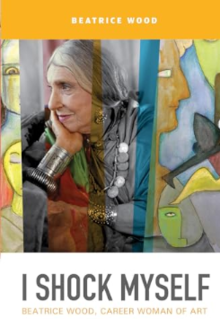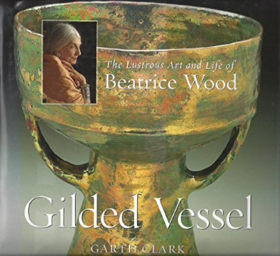Beatrice Wood: Difference between revisions
| Line 20: | Line 20: | ||
[[File:Beatrice Wood with Marcel Duchamp.jpg|right|150px|thumb|Beatrice Wood with Marcel Duchamps and Francis Picabia, 1917]] | [[File:Beatrice Wood with Marcel Duchamp.jpg|right|150px|thumb|Beatrice Wood with Marcel Duchamps and Francis Picabia, 1917]] | ||
=== Years in New York === | === Years in New York === | ||
Beatrice met Marcel Duchamps, who became famous for the Modernist painting ''Nude Descending a Staircase'' when it was displayed at the 1913 Armory Show. He and Henri-Pierre Roché had a close relationship with Beatrice, which | Beatrice met Marcel Duchamps, who became famous for the Modernist painting ''Nude Descending a Staircase'' when it was displayed at the 1913 Armory Show. He and Henri-Pierre Roché had a close relationship with Beatrice, which has been called a love triangle. | ||
In 1918 she | In 1918 she began a brief marriage to Belgian theater manager Paul Henson. | ||
<br> | <br> | ||
<br> | <br> | ||
Revision as of 16:28, 6 March 2024
UNDER CONSTRUCTION
UNDER CONSTRUCTION
Beatrice Wood was an American ceramicist and writer who was influential in the Avant Garde movement. Known as "Beato" and the "Mama of Dada," she was a life member of the Theosophical Society in America. A photo essay of her life appears on the website of the Beatrice Wood Center for the Arts.
Early life
Beatrice Wood was born in San Francisco on March 3, 1893. Her mother was an elegant socialite, Caroline ("Carara") Rosencrantz Wood, and her father, Benjamin Wood, was a successful real estate broker. A son, Jefferson, was born two years after Beatrice. In 1898 the family moved to New York City, where Benjamin became a clothing manufacturer
Mrs. Wood focused on Beatrice's education with the goal in mind of her eventual "coming out" to New York society. At the age of seven she spent a year in a convent in Paris, learning French, and later was enrolled in Ely School, then the most fashionable finishing school in New York City. In 1910 Wood attended Shipley School in Bryn Mawr, Pennsylvania. Wood's formal education was rounded out with frequent trips to Europe. Accompanied by her mother, she regularly visited art galleries and museums and attended the theater.[1]
Young Beatrice
Years in France
When Beatrice rebelled against the society life expected of a young lady, her mother sent her to Paris to study drawing at the Julien Academy. Then the young woman took herself off to Giverny to paint in a garret in the countryside. Her mother moved her back to Paris, but her daughter decided to take up acting rather than to continue painting. She took private instruction in acting and dancing with members of the Comédie Française.
Years in New York
Beatrice met Marcel Duchamps, who became famous for the Modernist painting Nude Descending a Staircase when it was displayed at the 1913 Armory Show. He and Henri-Pierre Roché had a close relationship with Beatrice, which has been called a love triangle.
In 1918 she began a brief marriage to Belgian theater manager Paul Henson.
Artistic career
Training
In 1928 Wood moved to California. Her first exposure to ceramics was an adult education course at Hollywood High School, which she had taken to learn how to make a teapot to match some luster-glaze plates she had bought in Holland. A deepening interest in ceramics led her to study with renowned potters Otto and Gertrud Natzler.[2]
Theosophical influence in her art
Miss Wood wrote an article for The Star called "Color, Light, and Art" reflecting her interest in the color theory expressed by Theosophists Annie Besant and Charles Webster Leadbeater in their book Thought Forms: "as a person evolves, he desires fresher, clearer colors, for they are a reflection on the physical plane of what is taking place on the inner planes. Leadbeater explains in Man Visible and Invisible (1903) that the colors in the aura of a highly developed man are translucent, pure, and radiant, and those of the lowly developed man are muddy, dark and 'dirty' in hue."
"Translucent, pure, and radiant" are words which also perfectly describe Wood’s luster-glazed vessels. A luster glaze is a fired, glass-like surface on a clay body, where metallic salts on the glaze’s surface give it an iridescent appearance. Wood achieved these brilliant luster glazes through reduction firing which requires the absorption of oxygen from both clay and glaze...
Just as the Theosophical texts advocate for a sort of spiritual cleansing through purification of color, Wood’s life-long study of techniques in luster glazing reflect a similar dedication to a mastery of brilliance. Her luster-glazed vessels in their radiant hues reflecting not only gold but bright purples, pinks, and blues upon closer examination, evoke a sense of alchemical perfection, demanding a kind of reverence only reserved for the sacred and otherworldly. Wood’s extraordinary sense of light and color become even more magnificent as her work is handled and examined— changing colors as the light moves and refracts from the vessel in different ways.[3]
Gallery of her works
Miss Wood created ceramics in many forms, including bowls, plates, chalices, and whimsical figurines. Sometimes she incorporated crystals into the bases of the figures. These are some examples of her many pots.
Theosophical Society involvement
Beatrice Wood was admitted as a member of the American Theosophical Society on December 1, 1923, sponsored by Russell Lloyd Jones and Leila E. Jones. She was initially a national member-at-large, but joined the Service Lodge in New York on November 17, 1924.[4] She was probably considered to be a charter member, as the charter was officially issued on the 15th. The charter was signed by 47 people, not all of whom were named, and within a few years it had grown to over 70 people.[5] She participated in this very active lodge during the 1920s, serving as sponsor for several new members. In 1926 she would have heard Fenn Germer, an associate of Thomas Wilfred and his "color organ," lecturing on color theory. She herself lectured on "The Life of Madame Blavatsky."[6]
The New York area Theosophists were active socially, as well. Young Dora van Gelder stayed with Beatrice Wood, and also visited the homes of the Sellon family and of Robert and Sara Logan early in 1927 in New York and New Jersey, before marrying Fritz Kunz on May 16th. Intermittently Miss Wood lived in the Old Hollywood neighborhood in which the Krotona Theosophical colony had been prominent during 1911-1923 before it moved to Ojai in 1924. Her next-door neighbors were L. W. Rogers, his wife Maysie, and sons Stanley and Grayson, who lived at 2033 N. Argyle Avenue.[7]
During the 1940s, Miss Wood served as a member of the selection committee for the Olcott Foundation Awards, a program to encourage creativity among members of the Theosophical Society.
Jiddu Krishnamurti was a friend, and he influenced her work.[8]
She maintained her Theosophical Society membership until her death in 1998, when she was the "seniormost" member after 73 years of participation.
Plays on Theosophical subjects
Miss Wood wrote plays that she intended to be performed by Theosophical Society lodges. In 1931 The Theosophical Messenger reported:
"Beatrice Wood sends word that she has just completed a one-act play dealing with life after death that is suitable for Lodge production. It has four characters and is not difficult to set. She will be glad to send it to any Lodge interested. Perhaps this play would be valuable as a means of spreading theosophical truth.[9]
The following year,
The Theosophical Press will undertake the publication of two Theosophical plays by Beatrice Wood, The Door That Did Not Close and Corridor E, if a sufficient number of orders are guaranteed in advance. The Door That Did Not Close has already been produced with genuine success by several lodges and the second new play comes highly recommended.[10]
Writings
In 1982, Miss Wood published The Angel Who Wore Black Tights, a memoir of her 1930 travels with her dear friend, actress Helen Freeman, to the Star Camp in The Netherlands. It was self-published through Rogue Press in Ojai, and illustrated with charming line drawings highlighted in red. She had written the narrative many years previously, and described it in an introduction:
This is a serious narrative, though some may think otherwise. It is about a trip to Holland taken by two girls, an actress and an artist. It is an experience, not a novel.
The two had been invited by Mr. Jiddu Krishnamurti to visit for three weeks at Castle Eerde in Ommen, where he was giving a series of informal talks to friends. The talks were to be followed later by addresses to thousands who had come form all over the world to be together for one week to listen to his wisdom.
Beatrice Wood and Helen Freeman considered the visit to be of singular importance. That their conversations were gay and light was according to the idiom of their time; in the deeper realms of their beings the impact of Krishnamurti's though was continually breaking through their banter.
A longer autobiography, I Shock Myself: The Autobiography of Beatrice Wood, was published in 1985 by Chronicle Books, San Francisco. Edited by Lindsay Smith, it is lavishly illustrated with photographs of Wood's life and art.
The Union Index of Theosophical Periodicals lists 22 articles written by Beatrice Wood and four about her.
Later years
Miss Wood continued her work with ceramics until 1997. When she was 100 years old, she delivered a commencement address at the Besant Hill School of Happy Valley.[11] Two years before her death, Miss Wood was recognized at the annual convention as "the seniormost Fellow of the Theosophical Society in America in years of age in this incarnation." She was then 103 years old. In a series of resolutions, the artist was acclaimed a "one of our most faithful members" and "a world-famous ceramicist, artist, chocolate connoisseur, and inspirer of young men, as well as a greatly admired, honored, and loved member of the Theosphical Society who throughout her life has exemplified high ideals of art and living."[12]
She died in Ojai on March 12, 1998, nine days after her 105th birthday. She famously attributed her longevity to "young men and chocolate."
Legacy
The Beatrice Wood Center for the Arts is located in Ojai, California. In addition to museum space dedicated to Beatrice Wood, the center offers workshops in various arts, musical performances, and exhibitions.
The center has hosted such Theosophical events as a 3-day workshop with lectures by Richard Flores and Kevin Wallace on April 12-14, 2013:
This three-day workshop is based upon Thought Forms, the 1901 book by Annie Besant and Charles Leadbeater that inspired Wassily Kandinsky, Piet Mondrian, Paul Klee and countless other artists. Participants will explore the ideas that pre-date and inspired abstract painting through insights into the processes of seeing and recording impressions in form and color.[13]
Museum collections
These are some of the museum with major collections of Miss Wood's work. For a more complete list, see Garth Clark, The Gilded Vessel.[14]
- American Craft Museum, New York
- Museum of Fine Arts, Houston.
- Bruce Jewitt Collection at CalPolyPomona.
- Smithsonian American Art Museum.
- Whitney Museum of American Art. Drawings.
- Santa Barbara Museum of Art. Drawings.
- Los Angeles County Museum of Art.
Awards and prizes
- 1961 – Goodwill Ambassador from the United States to India
- 1983 – Symposium Award of the Institute for Ceramic History
- 1984 – Living Treasure of California
- 1987 – Fellow of American Craft Council Women's Art Caucus
- 1987 – National Council on Education for the Ceramic Arts Award
- 1988 – Distinguished Service Award, Arizona State University
- 1992 – Gold Medal for Highest Achievement in Craftsmanship, American Craft Council
- 1994 – Governor's Award for the Arts, State of California
- 1998 – Named "Esteemed American Artist” by the Smithsonian Institute
Characterizations in film
In his 1962 film Jules et Jim, François Truffaut depicted a love triangle based on a semi-autobiographical novel written by Henri-Pierre Roché in 1953. The woman in the triangle was inspired by Beatrice Wood, who had been in such a relationship with Roché and Marcel Duchamp whilte working in New York on Dada magazines.
The character of Rose DeWitt Bukater, "Old Rose," in the film Titanic was modeled after Beatrice Wood after director James Cameron read Wood's autobiography.
She couldn’t go to the premiere of Titanic so James Cameron and Gloria Stuart brought the video to her. She refused to watch it. She said it was too late in life to be sad.[15]
Additional resources
Archival records
- Beatrice Wood papers, 1894-1998, bulk 1930-1990 at the Archives of American Art, Smithsonian Institute. Includes diaries; oral histories; art works and glaze books; correspondence; personal business records; photographs; and writings, such as drafts of her plays.
- Beatrice Wood Collection at Philadelphia Museum of Art. Correspondence of Conrad C. M. Arensberg, mostly 1978-2001.
Books
- Clark, Garth. Gilded Vessel: The Lustrous Life and Art of Beatrice Wood. Guild Publishing, 2001.
- Naumann, Francis M., ed. Beatrice Wood: A Centennial Tribute. New York: American Craft Museum, 1997.
- Wallace, Marlene. 'Playing Chess With the Heart: Beatrice Wood at 100. San Francisco: Chronicle Books, 1994.
Video
- Excerpts from Beatrice Wood: Mama of Dada, a 1993 documentary film written and directed by Tom Neff.
- Life Is an Art from Beatrice Wood Center for the Arts.
- Beatrice Wood Permanent Collection Tour by Kevin Wallace. Posted on YouTube on July 21, 2020. "A short video sharing a selection of ceramic works by Beatrice Wood, from the permanent collection of the Beatrice Wood Center for the Arts in Ojai, California."
- Beatrice Wood by David Naranjo. Posted on YouTube on September 30, 2009. Interview with the artist, showing her glazing her ceramics.
- Beatrice Wood at 97 Excerpt by Carole Ewing McCartney. Posted on YouTube on December 8, 2013.
- Beatrice Wood 1993 Commencement Address Excerpt at Besant Hill School of Happy Valley.
- Beatrice Wood Remembers: Dada, Duchamp. Love & Tango. A Conversation with Beatrice Wood directed and written by Steven Watson. Interview conducted October, 1987 in Philadelphia, Pennsylvania. Posted on YouTube on August 10, 2019.
- Elaine Lipworth's Interview with artist Beatrice Wood for her 100th Birthday. 1993. Posted by Elain Lipworth on her YouTube channel on December 23, 2020.
Websites
- Beatrice Wood Center for the Arts.
- [=6279 Smithsonian Institute website] offers a gallery of 32 of Wood's works - ceramics, drawings, and watercolors.
Notes
- ↑ Garth Clark Gilded Vessel: The Lustrous Art and Life of Beatrice Wood (Madison, Wisc: Guild Publishing, 2001), 71.
- ↑ "Artist Beatrice Wood"
- ↑ Rachel Denniston "Beatrice Wood, the Alchemist Cult Artist Turning Mothballs into Gold" California Art Review posted November 20, 2022.
- ↑ Membership Ledger Cards Roll 8 no. 02553-02554 and Ledger Sheets Roll 7 no. 01507-01508. Theosophical Society in America Archives.
- ↑ Service Lodge in Lodge Charter Records. Theosophical Society in America Archives.
- ↑ Service Lodge program schedule for 1926. Theosophical Society in America Archives.
- ↑ Beatrice Wood in 1930 U. S. Federal Census.
- ↑ "The Life of Jiddu Krishnamurti" in KatinkaHesselink website.
- ↑ "A New Play," The Theosophical Messenger 19.3 (March 1931), 338.
- ↑ "Occult Plays," The Theosophical Messenger 20.9 (September 1932), 208.
- ↑ Beatrice Wood 1993 Commencement Address Excerpt at Besant Hill School of Happy Valley.
- ↑ "Convention Resolutions," The American Theosophist 84 no.6 (Early Autumn, 1996), 10.
- ↑ "Thought Forms," Beatrice Wood Center for the Arts at Beatrice Wood Center website. Accessed January 13, 2016. See also Biennial website.
- ↑ Garth Clark, The Gilded Vessel: The Lustrous Art and Life of Beatrice Wood Madison, Wisconsin: Guild Publishing, 2001. See page 122.
- ↑ Sandip Roy, "How I met the real Rose of Titanic" Posted on FirstPost on April 6, 2012. Based on an interview done for India Currents magazine.
